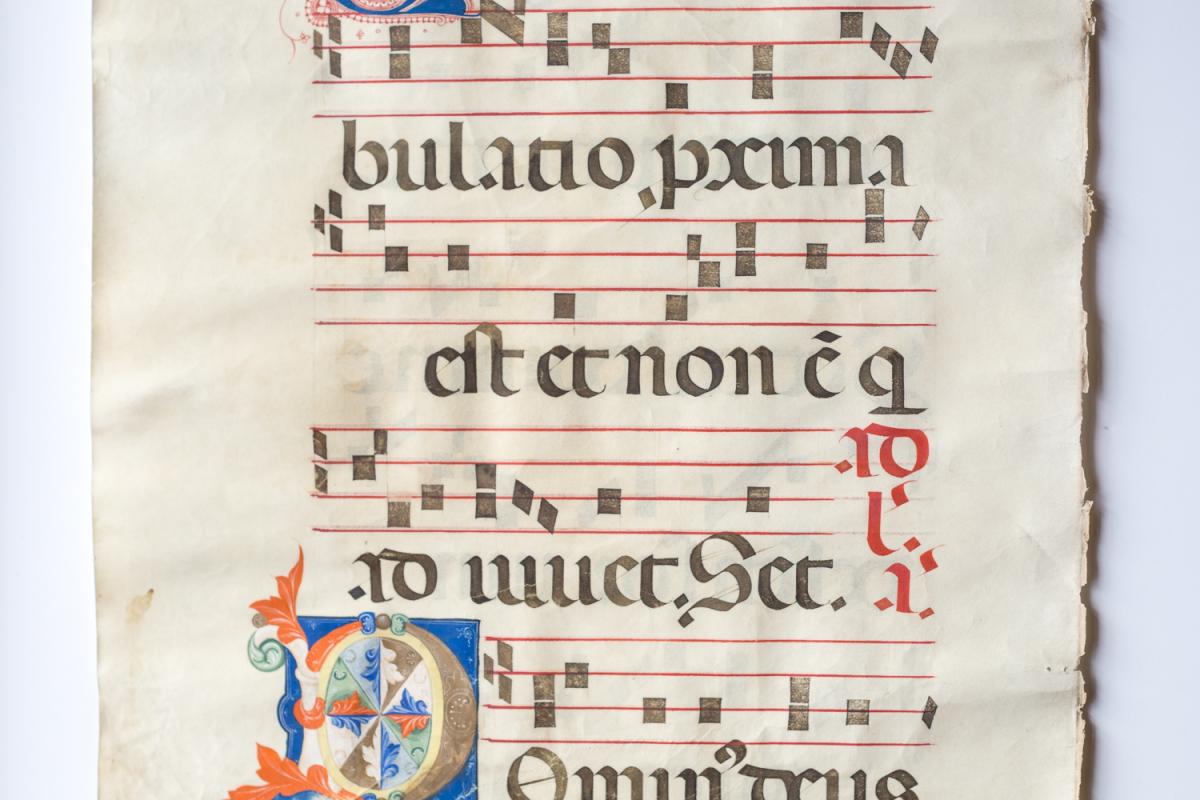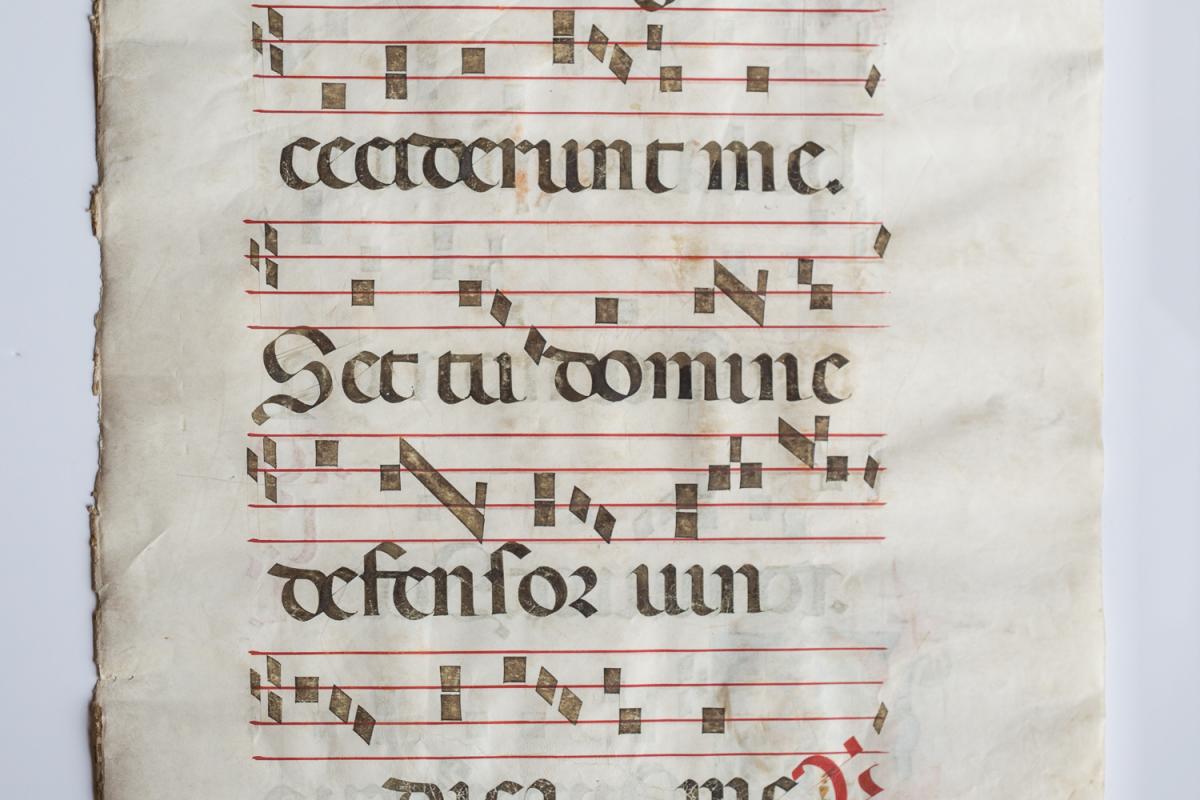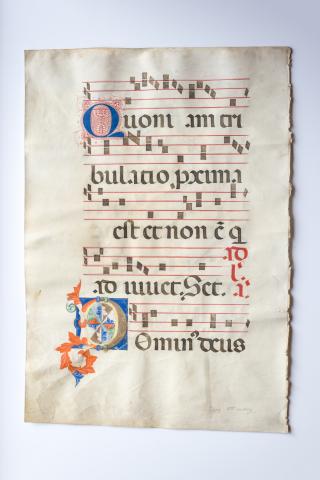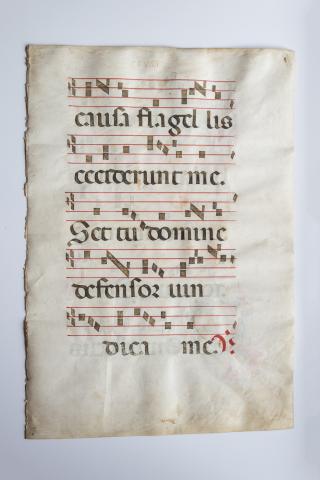Antiphonal Leaf
Antiphonal Leaf
Italian (Siena), 14th century
Language: Latin
Single leaf
ink on vellum
height 23-1/4 inches
width 16-1/4 inches
Breviarium. Vespers for Passion Sunday. One vellum leaf foliated CCVIIII [209]. Five lines of music with neumes in brownish ink on four red lines. Large initial Q[uoniarn] (60 x 70 mm.) painted blue with red filigree. Initial: D[ominus] (80 x 85 mm.:) with leaves. Labeled: Siena XIV century on verso bottom margin.
[R. Circumdederunt me uiri mendaces sine] causa flagellis ceciderunt me. Set tu domine defensor
uindica me V.
[verso]
Quoniam tribulatio proxima est et non est quod iuuet. Set. Ad Ant. Domine deus
Jeffrey Arnsdorf, Graduate Student, Spring 2018
Overview
Held in the John Wilson Special Collections of the Multnomah County Library, Ms. S.N. (3) is a large antiphonary leaf, measuring 23.25 x 16.25 inches. On the leaf, three chants for the feast of Palm Sunday are represented. Based on paleographic and stylistic markers, it was likely produced in Tuscany between the late thirteenth or fourteenth centuries, and the full antiphonary ran four to five hundred pages.
Physical description
The recto is marked CCVIIII at the top of the page in a light, informal hand that appears to be the same or similar color and quality of ink as the rest of the manuscript text. Five staves of notated music follow. The staves are made up of four red lines, and the bold, square-note notation is written in a dark brown. The lyrics to the chant are in a well-formed, Gothic rotunda hand. The ink is a dark brown that is slightly darker than the notation. This is followed by a red 'V.' The verso contains another five staves of notation with text in the same hand as the recto. Additionally, in red letters to the right of the fourth staff, running vertically are the words "ad / l'. / a'." The first line of text begins with an ornate capital 'Q.' in blue, surrounded and filled with ornate red filigree. The last line of text begins with a foliated capital 'D' in orange, brown, blue, white, green, and yellow that bears no resemblance to the 'Q' at the top of the page.
"Siena XIV century" is written in a modern hand in the bottom right corner of the page. The manuscript is in fair condition, save some smudging in the brown paint at the bottom of the 'D,' and some damage to the blue background field and orange and white foliation, where it appears the manuscript has been wrinkled.
The Chant
The chants represented on this manuscript leaf are for the Office [clarify office] for Palm Sunday. which falls on the Sunday before Easter.[1] A significant feast day falling on the Sunday before Easter, Palm Sunday commemorates Christ's triumphant entrance into Jerusalem one week before his resurrection.
The text on the recto is the second half of a response for matins. The longest hour of the Office, matins takes place in the early hours of the morning and ends at daybreak. Along with lauds and vespers, it tends to be the most musically developed. In its entirety, the text reads: [Circumdederunt me viri menadeces sine] causa flagellis / ceciderunt me. / Set tu domine / defensor uin/dica me. (Lying men have surrounded me; without cause they have cut me with whips, but you Lord my defender avenge me.) On the verso is the corresponding response verse, also for matins: Quoniam tri/bulatio p[ro]xima / est et non e[st] q[ui] / adiuuet. Set. / Domin[us] deus. (Because tribulation is near to me and there is no one to help. But.)
This is followed by the first words of an antiphon for lauds, the full text of which reads: Dominus deus [auxiliator meus et ideo non sum confusus.] (The Lord God is my helper and therefore I am not confounded.) Note that the verse ends with the single word set. This is the cue for the choir to repeat the second half of the response, starting at the words, set tu domine.
Responsories are made up of a response sung by the choir and a verse sung by a solo cantor, and they represent the second largest chant type in the Roman repertory, second only to Office antiphons. The verse, here marked by a stylized, red, capital “V,” is often followed by a repeat of the end of the response, again sung by the full choir. The two parts of the responsory are thematically tied and work as a unit. So, after the cantor sings that "there is no one to help," the choir responds, "but you lord, my defender, avenge me." The text for response verses is usually derived, sometimes inexactly, from a psalm. Here, the verse is based on Psalm 21:12, which, in the Vulgate, reads, ne discesseris a me quoniam tribulatio proxima est quoniam non est qui adiuvet. (Do not depart from me, because tribulation is most nigh and there is no one to help.) After the verse, the red lettering again heralds the next chant, in this case an antiphon for lauds. Ad l'. a'. is an abbreviation for ad laudes antiphona. Ad laudes signals the shift in hour from matins to lauds. This antiphon is based on Isaiah 50:7, which, in the Vulgate, reads dominus Deus auxiliator meus ideo non sum confusus ideo posui faciem meam ut petram durissimam et scio quoniam non confundar. (For the Lord God will help me; therefore shall I not be confounded: therefore have I set my face like a flint, and I know that I shall not be ashamed.)
Establishing date and provenance
Although Ms. S.N. (3) is marked "Siena XIV° century," this is almost certainly the opinion of a modern art dealer and is entirely unverified. However, an analysis of the illuminated initials, the script, and elements of the notation does suggest a late-medieval Tuscan attribution. That relative confidence notwithstanding, certain idiosyncrasies resist firm analysis, and the manuscript’s date and provenance must remain an open question.
The illuminated initials. The 'Q' at the top of the verso is painted blue and is surrounded by and filled in with fine, detailed, red pen work. The interior is a near-symmetrical figure of two stacked, patterned circles filled with a floriate design (the top one is oriented horizontally, the bottom vertically), while the intervening spaces are filled with the same pattern that makes up the circles. The tail of the 'Q' moves off from the bottom right. The bottom left, top left, and top right of the 'Q' are decorated with circles, each containing three circles in negative space. In the space around each of the corner circles are arching, delicate, single-line 'branches.' The 'Q' is encircled by two red lines which are topped with an interlocking fence motif. A few circles and circular ‘berry’ clusters hover around the outside of the ‘Q’ and at the ends of the 'branches.' All of this pen work is very clean and uniform.
Variations of this style of initial, (blue with red filigree or vice versa) can be found in manuscripts from England, France, the Low Countries, and Germany as well as Italy, so its presence here does not help us secure a place of origin for Ms. S.N. (3). In fact, there is a striking resemblance between the decoration on this initial and those found on a fourteenth-century Franciscan antiphoner of probable South German provenance.[2] Specifically, a 'U on folio 1r utilizes negative-space circles and is filled with a floriate design almost identical to those that fill Ms. S.N. (3)'s 'D.' In other respects, the two manuscripts share little in common. One wonders if there are cultural ties between non-Italian Franciscan orders and central Italy, due to Francis’s start in Assisi.
The 'D' at the bottom of the verso and its foliated tail are painted orange, brown, blue, white, green, and yellow. The interior of the 'D' is divided diametrically into eight, roughly-equal 'pie slices,' which are decorated symmetrically with four leaf shapes. The top and bottom leaves are painted blue and white, and the left and right leaves are orange and blue. The 'pie slices' themselves are painted, alternately, brown, white, green, and blue. Their interior borders are decorated with fine, white pen work. The 'D' sits on a somewhat square, blue field, the interior borders of which are decorated with fine, white pen work. The left side of the 'D' is decorated with abundant and flourishing foliation in orange, white, and blue creating a long and curling tail at the bottom. The foliation throughout this capital is marked by a high degree of detail including very-fine pen work and shading. Additional decorative elements include a 'knot' on the shaft of the 'D' and blue and green stylized 'c' shapes separated by a brown 'ball' at the top and bottom of the 'D.' This 'c' motif can also be found in the interior pen work.
The orange, green, and blue found in the initial 'D' are very common in later-medieval manuscript illuminations from Tuscany and the surrounding area. Pink is also commonly found in these manuscripts, although it is absent from this leaf. Foliate decoration is also a trademark of these illuminations. Fine white pen work on a blue field, likewise, is not uncommon. A close look at the patterns of that penwork reveals a high degree of verisimilitude with that found in an initial 'B' in a late thirteenth-century Sienese antiphonary.[3] Most striking, however, is the similarity between the 'knots' and 'c' shapes in Ms. S.N. (3) and those found in the work of Niccolò di Ser Sozzo (d. 1363). In addition to a blue field with white pen work and orange and green foliate decoration, a historiated initial 'B' by Niccolò has several instances of 'c' shapes separated by 'balls' and a 'knot.'[4] On the other hand, the detail of the foliate decoration lacks the intricacy of that found Ms. S.N. (3). That detail is seen on a quite elaborate initial 'B' from a late-fourteenth-century gradual, the foliation for which was done by Sienese illuminator Don Simone Camaldolese.[5] Another interesting feature of this illumination is the presence of a blue initial filled with and surrounded by red filigree on the same page. This establishes a precedent for the juxtaposition of these two distinct styles on a single page in Sienese manuscripts.
The notation: The music on Ms. S.N. (3) is written in square note notation, a system widely used for monophony from the twelfth century onward. Square note is marked by its use of ligatures—groups of notes combined in one symbol. Ligatures could make it easier to squeeze multiple notes under a single syllable in the text. Because there are a number of ways a given melody could be notated using various note shapes and ligatures, it is possible to see cultural ties between different manuscripts that notate their chants in the same way. The chants represented on Ms. S.N. (3) appear on well over a hundred other manuscripts.[6] By analyzing the variety in the details of these melodies and their notation, it is possible to map temporal and/or geographic relationships based on coincidences in the sources. A survey of the melodies of these chants and the way they are notated, indeed, revealed a high degree of similarity between Ms. S.N. (3) and Italian manuscripts from the thirteenth and fourteenth centuries. In light of the Franciscan connection in the initial 'Q,' it is interesting that a late thirteenth-century Franciscan antiphonary (place of origin unknown) also showed a very high degree of similarity.[7]
That Ms. S.N. (3) is of Italian origin is certain. The predominance of orange, blue, and green in the foliate design and the gothic rotunda script all point to Italy, if not Tuscany in particular. The details of the chant melodies and their use for Palm Sunday also lends support to an Italian provenance. Further, that certain details in the initial 'D' match those of a Sienese manuscript illuminator suggests Siena as a possible place of origin, though the nature of the evidence demands that this remains a speculation.
Click here to see a modern transcription of Quoniam tribulatio, and here to hear a performance of it by a solo cantor.
Notes
[1] In some liturgies, the response found on this leaf is used for vespers on Passion Sunday.
[2] MS.1996.097, held at John J. Burns Library, Boston College. The quality of the line-work on the Franciscan antiphoner, however, does not equal that found on our ‘D.’
[3] Virgin and Child and God the Father Blessing in an Initial B by Duccio di Buoninsegna. Held at the Metropolitan Museum of Art, New York (cat. no. 27).
[4] The Free Library of Philadelphia, Rare Book Department, Lewis E M 25.5 (single cutting from a Gradual). These features show up in other illuminations by Noccolò, as well
[5] The Trinity in an Initial B, held at the Metropolitan Museum of Art, New York (1975.I.2476). Palladino, Treasures of a Lost Art, 55.
[6]http://cantus.uwaterloo.ca/search?op=starts&t=&genre=All&cid=006287&mode=&feast=&volpiano=All; |http://cantus.uwaterloo.ca/search?op=starts&t=&genre=All&cid=002405&mode=&feast=&volpiano=All|
[7] Fribourg, Bibliothèque des Cordeliers, 2. "Quoniam Tribulatio Proxima Est et | Cantus Manuscript Database," accessed December 2, 2018, http://cantus.uwaterloo.ca/node/254825.
Bibliography
Benedictine monk. The Beginner’s Book of Chant: A Simple Guide for Parishes Schools and Communities. Farnborough, Hampshire: Saint Michael’s Abbey Press, 2003.
Bischoff, Bernhard. Latin Palaeography: Antiquity and the Middle Ages. Cambridge: Cambridge University Press, 1990.
Cattin, Giulio. Music of the Middle Ages. Cambridge: Cambridge University Press, 1984.
Hiley, David. Western Plainchant: A Handbook. Oxford: Oxford University Press, 1993.
Murray, Gregory. Gregorian Chant, According to the Manuscripts. London: LJ Cary, 1963.
Norman, Diana. Painting in Late Medieval and Renaissance Siena (1260-1555). New Haven: Yale University Press, 2003.
Palladino, Pia. Art and Devotion in Siena after 1350: Luca Di Tommè and Niccolò Di Buonaccorso. San Diego: Timken Museum of Art, 1997.
———. Treasures of a Lost Art: Italian Manuscript Painting of the Middle Ages and Renaissance. New Haven: Metropolitan Museum of Art, Yale University Press, 2003.
Steiner, Ruth, Margot Elsbeth Fassler, and Rebecca Anne Baltzer. The Divine Office in the Latin Middle Ages: Methodology and Source Studies, Regional Developments, Hagiography: Written in Honor of Professor Ruth Steiner. New York: Oxford University Press, 2000.
Taruskin, Richard. The Oxford History of Western Music. Vol. V. 1. The earliest notations to the sixteenth century. Oxford: Oxford University Press, 2005.
Troeger, Thomas H. Music as Prayer: The Theology and Practice of Church Music. New York: Oxford University Press, 2013




